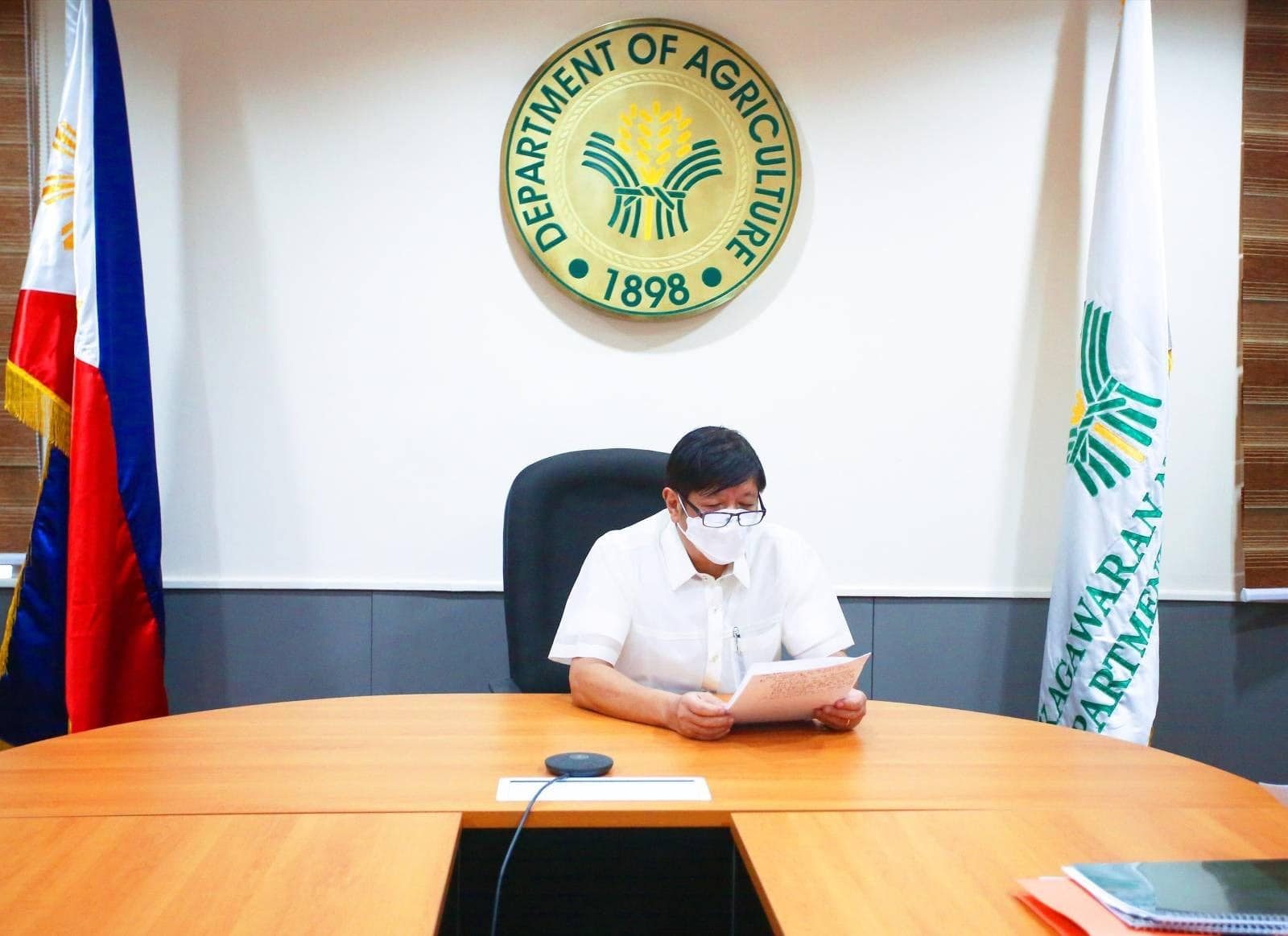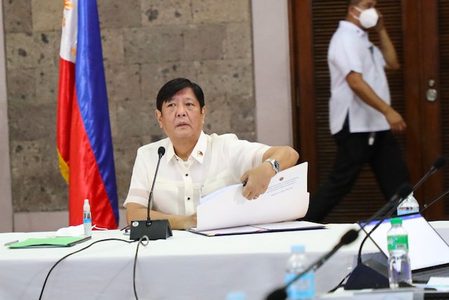SUMMARY
This is AI generated summarization, which may have errors. For context, always refer to the full article.

MANILA, Philippines – Philippine President Ferdinand Marcos Jr. is set to deliver his first State of the Nation Address (SONA), and cap his first month as agriculture secretary, amid soaring prices of basic commodities, especially food.
Skyrocketing cost of sugar, flour, and eggs are taking a heavy toll on businesses and consumers. Fertilizer prices have tripled in some areas, painful for farmers whose incomes are already suffering from high fuel prices and an inability to compete with cheaper imported goods.
In a way, Marcos’ decision to serve as agriculture chief is a gutsy one because of the gargantuan challenge of uplifting a sector so long neglected, and one close to the stomachs of so many Filipinos. Unlike presidents who had alter-egos who could absorb the blame, the buck stops with Marcos here.
No wonder his campaign promise to bring the price of rice to P20 per kilogram got a lot of attention from ordinary Filipinos.
“Siya na nakaupo sa gobyerno, sana ‘yung pangako niya matupad na (He’s the one now in power, we hope he lives up to his promise),” said Marikina baker Ado Bartolata who’s had to halve the weight of his monay and add a peso to its price because of the high cost of ingredients.
What has Marcos done in his first month as agriculture secretary?
Tall order
Department of Agriculture Undersecretary-designate and spokesperson Kristine Evangelista described Marcos in his first 30 days as a “hands-on” agriculture chief. But his dealings so far have been mostly to take stock of the state of the agricultural sector and gather recommendations from both government and the private sector.
“He was very particular about increasing production. So now, it’s a review of all the programs we’re doing and which one of that actually leads to that direction of increasing production,” she said in a Rappler Talk interview.

“Second, you’re also looking into how to increase the income of the farmers…. I think he’s very hands-on, and he really wants to be able to solve problems that have been perennial also, as far as agriculture is concerned,” added Evangelista.
The meetings have led to these directives from Marcos:
- A general marching order to boost production of rice, corn, vegetables, pork, and poultry
- A general marching order to “reconstruct” agricultural value chains so farmers and other producers have more income
- Come up with a master plan of farm-to-market roads to make transportation of agricultural goods more efficient, thus reducing costs
- Review the rice tariffication law and how it’s affected local farmers, and whether or not it should be amended to once again allow the National Food Authority to import
- Study the proposal to implement “Masagana 150” as a way to increase the yield per hectare of rice land by providing farmers with loans to purchase high-yielding rice varieties, fertilizer, and pesticides
- Study government-to-government purchase of affordable fertilizer so farmers can have access to cheaper fertilizer
- Study the implementation of a suggested retail price for sugar
The first three could take months or years to implement and are more of mid-term to long-term plans. The last two, G2G and a sugar SRP, are urgent directives meant as immediate measures to cushion farmers and consumers from pricier fertilizer and sugar, respectively.
But Marcos’ biggest contribution to the agricultural sector may be the powerful optics borne of his decision to lead the agriculture department himself. The move was a big message and a morale-booster to the department.
“I think things might happen faster than they used to because there is more focus and there is a lot of attention,” said Evangelista, recalling how other government agencies have been instructed to be attentive to needs of the agri sector.
Weekly meetings
Evangelista was present in the three “executive committee” meetings Marcos had held with DA officials, including one held virtually because the Chief Executive at the time had COVID-19.

Aside from these large meetings, Marcos, or his Malacañang staff at least, supposedly touched base with the DA daily. It was Executive Secretary Vic Rodriguez who asked Evangelista to be department spokesperson so that, apart from Marcos himself, there would be another talking head to take media queries and project action to the public.
Marcos’ point person in the DA is Undersecretary Leocadio Sebastian who formerly had been chief of staff of the previous agriculture secretary, William Dar.
Apart from the DA meetings, Marcos has held one meeting with members of his Private Sector Advisory Council focused on food security, and took up agriculture and inflation in at least one of his three Cabinet meetings.
His first press conference as President largely dealt with agriculture and food security, specifically things he had discussed in his first meeting with DA officials on July 4.
“That is why I made agriculture the single, the highest priority of everything that we are doing,” said Marcos the day after, July 5.
“Because you cannot build a strong economy unless you have a foundation of a robust agricultural sector, which assures food supply even in emergencies. And that’s what we’re working towards. That’s the long-term plan,” he added.
Criticisms
Not everyone is happy with Marcos’ plans so far.
Progressive groups Pamalakaya panned his farm-to-market road network plan as being unresponsive to the issue of rising costs of agricultural production.
“Anong silbi ng farm-to-market roads kung wala namang produktong [maibibiyahe] dahil bagsak ang [produksiyon] ng mga mangingisda’t magsasaka dulot ng taas-presyo ng mga gastusin?” they said in a press release.
(What is the use of farm-to-market roads if there are no products to transport because the production of fishers and farmers is depleted because of the high costs of production?)
“Roads and infrastructure are not the solution to achieve food security if the producers of food are not supported,” they added in Filipino.

The Kilusang Magbubukid ng Pilipinas had the same issue with the proposed Masagana 150.
“You can’t just increase the average yield. What’s needed are production subsidies, help in post-harvest, and increasing the price of palay (unmilled rice),” said the group.
Both groups are pushing for a law that would give all farmers and fishers P10,000 in cash aid and P15,000 for buying production inputs like fertilizer and pesticides.
These groups also want Marcos to repeal the rice tarrification law, suspend excise tax on oil products, prohibit the conversion of agricultural land or land suitable for planting staple crops, resolve “long-standing agrarian disputes” like that of Hacienda Tinang in Tarlac, allocate 10% of the national budget to agriculture and food production, among others.
‘Food sovereignty’
Marcos and progressive groups agree on one thing: the need to reduce reliance on importation of agricultural products.
Currently, the government often needs to import to stabilize prices of food staples like rice, sugar, and more. In the case of rice, the rice tarrification law lifted all quantity restrictions on imported rice, and imposed tariffs on rice from abroad instead.
But Filipino farmers have said the policy depleted their incomes because the rice they sell can’t compete in terms of price with the imported rice from countries like Vietnam and Thailand where the agricultural sector benefits from larger subsidies.

Marcos has ordered a review of the rice tarrification law but is yet to decide whether he will seek amendments or its scrapping.
Executive Secretary Vic Rodriguez, on the Friday before the SONA, said reducing dependence on imports is a key aim of the President.
“His vision for us is not only to have food security but food sovereignty,” he told reporters. “Meaning, we don’t have to rely on much importation anymore. If we can feed ourselves as a nation, if we can feed ourselves as Filipinos, I think we are on our way to where we want to be much like where our neighbors are,” he continued.
Marcos himself said in his first presidential media briefing: “We would prefer to import as little as possible.”
He especially mentioned the need to improve self-sufficiency in corn because, with the choking of wheat supply due to the Russia-Ukraine war, corn became a substitute for the now more expensive crop.
Corn is critical because it is used both as food and as feed for other agricultural products like chicken and pork.
But to achieve self-sufficiency in staple crops, farmers have to have the motivation to continue in their livelihood. For this to happen, their incomes from agricultural work have to improve.
Food price crisis
Not once did Marcos specifically mention his “P20 per kilo of rice” promise in his DA meetings, said Evangelista. Marcos previously said this P20 price was an “aspiration” of his government.
“We are working on it,” said Evangelista about the promise.
“We don’t talk about the P20 figure but we talk about bringing down the cost,” she added.
Marcos’ plan to make food in markets and groceries more affordable for Filipinos is to “reconstruct” value chains. This could also lead to higher incomes for farmers and other producers because consumers would buy more of their products since they are cheap.
But no concrete plan has been unveiled so far on how this will be done.
Marcos has mentioned a plan to “integrate” the disparate parts of the value chain – from harvesting, to transporting, to processing, to selling.
“There are elements of the value chain that are there but they are not part of a process, they exist stand-alone. So we will make them part of a whole so we can generate savings…. When you vertically integrate, there will be many savings along the line,” said Marcos on July 5.
The most specific this plan has gotten was mention of existing Kadiwa programs, in which the government helps bring agricultural products direct from farmers to consumers through strategically-located Kadiwa stores.
Marcos has also mentioned involving cooperatives and the Food Terminal Inc. (FTI) in mobilizing food. The FTI is a government agency with a mandate to bring agricultural products closer to vulnerable communities so that they are more affordable.
It’s only Marcos’ first month on the job. A foundation has been laid – and expectations set – for how he’ll turn the sector around. – Rappler.com
Add a comment
How does this make you feel?






![[In This Economy] Marcos’ POGO ban is popular, but will it work?](https://www.rappler.com/tachyon/2024/07/thought-leaders-marcos-pogo-ban.jpg?resize=257%2C257&crop=255px%2C0px%2C720px%2C720px)
![[Rappler Investigates] POGOs no-go as Typhoon Carina exits](https://www.rappler.com/tachyon/2024/07/newsletter-graphics-carina-pogo.jpg?resize=257%2C257&crop=424px%2C0px%2C1080px%2C1080px)





![[Just Saying] SONA 2024: Some disturbing points](https://www.rappler.com/tachyon/2024/07/TL-marcos-sona-points-july-23-2024.jpg?resize=257%2C257&crop=335px%2C0px%2C720px%2C720px)





There are no comments yet. Add your comment to start the conversation.